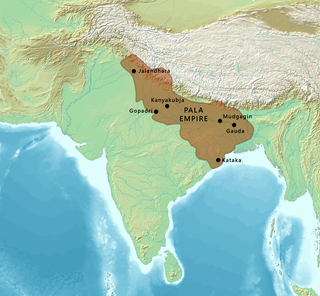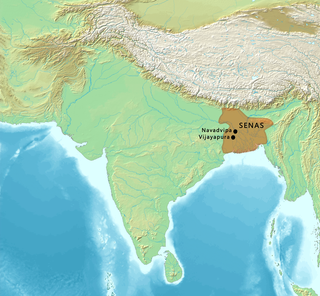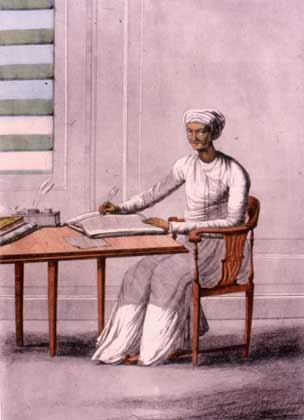Related Research Articles

The Pāla Empire was an imperial power during the post-classical period in the Indian subcontinent, which originated in the region of Bengal. It is named after its ruling dynasty, whose rulers bore names ending with the suffix Pāla. The empire was founded with the election of Gopāla as the emperor of Gauda in late eighth century CE. The Pala stronghold was located in Bengal and eastern Bihar, which included the major cities of Gauḍa, Vikramapura, Pāṭaliputra, Monghyr, Somapura, Ramavati (Varendra), Tāmralipta and Jagaddala.

The Sena dynasty was a Hindu dynasty during the early medieval period on the Indian subcontinent, that ruled from Bengal through the 11th and 12th centuries. The empire at its peak covered much of the north-eastern region of the Indian subcontinent. The rulers of the Sena Dynasty traced their origin to the south Indian region of Karnataka.

The history of Bengal is intertwined with the history of the broader Indian subcontinent and the surrounding regions of South Asia and Southeast Asia. It includes modern-day Bangladesh and the Indian states of West Bengal, Tripura and Assam's Karimganj district, located in the eastern part of the Indian subcontinent, at the apex of the Bay of Bengal and dominated by the fertile Ganges delta. The region was known to the ancient Greeks and Romans as Gangaridai, a powerful kingdom whose war elephant forces led the withdrawal of Alexander the Great from India. Some historians have identified Gangaridai with other parts of India. The Ganges and the Brahmaputra rivers act as a geographic marker of the region, but also connects the region to the broader Indian subcontinent. Bengal, at times, has played an important role in the history of the Indian subcontinent.

Bengali Brahmins are the community of Hindu Brahmins, who traditionally reside in the Bengal region of the Indian subcontinent, currently comprising the Indian state of West Bengal and the country of Bangladesh.

The Kamboja-Pala dynasty ruled parts of Bengal in the 10th to 11th centuries CE, after invading the Palas during the reign of Gopala III. The last Kamboja ruler of the Kamboja-Pala Dynasty Dharmapala was defeated by the south Indian Emperor Rajendra Chola I of the Chola dynasty in the 11th century.

Bikrampur was a historic region and a sub-division of Dhaka within the Bengal Presidency during the period of British India. Located along the banks of the Padma River, it was a significant cultural and political centre in Bengal. Today, the region is part of the Munshiganj District in Bangladesh.
Vigrahapala III was the successor to the Pala king Nayapala in the Bengal region of the Indian subcontinent, and twelfth ruler of the Pala line reigning for 15 years. He was succeeded by Mahipala II.
Ramapala also known as Ramapala the Great, was the successor to the Pala king Shurapala II in the Bengal region of the Indian subcontinent, and fifteenth ruler of the Pala line.
Madanapala was the successor to the Pala king Gopala IV in the Bengal region of the Indian subcontinent, and the eighteenth and final ruler of Pala lineage reigning for 18 years. He was succeeded by Govindapala, whose lineage of that name is questionable.
Lokkhon Sen or Lakshman Sena was the ruler from the Sen dynasty of the Bengal region on the Indian subcontinent. His rule lasted for 28 years.
Hemanta Sena, the founder of the Hindu Sena dynasty in the Bengal region of the Indian subcontinent.
Vijaya Sena, also known as Vijay Sen in vernacular literature, was the son of Hemanta Sena, and succeeded him as a Sena dynasty ruler of Bengal region of the Indian subcontinent. This dynasty ruled for more than 200 years. He conquered Bengal, fighting the kings of Gauda, Kamarupa, and Kalinga. He had a capital in Vijayapuri and Vikramapura.

Kulin Kayastha is a sub-caste of the Bengali Kayastha caste in Bengal region of Indian subcontinent. They are also known as the Kulina Kayasthas.
Baidya or Vaidya is a Bengali Hindu community located in the Bengal region of Indian subcontinent. A caste (jāti) of Ayurvedic physicians, the Baidyas have long had pre-eminence in society alongside Brahmins and Kayasthas. In the colonial era, the Bhadraloks were drawn primarily, but not exclusively, from these three upper castes, who continue to maintain a collective hegemony in West Bengal.

Sculpture has been an indispensable part of Bangladeshi culture. Bangladesh was at times an important centre influencing stone sculpture in South Asia, especially in the post-Gupta and medieval periods. Terracotta reliefs are a particular local characteristic of Hindu temples and mosques in recent centuries.
Kulinism or Kulin Pratha is a practice that envisages an elite position within the varna/jati configuration, derived from spiritual and ritual purity. Upper castes in Bengal were divided into exogamous classes, with ritual status determined by lineage purity and family marital history, with Kulins having the highest status. The Kulagranthas or Kulapanjikas are the foundational narrative of kulinism in Bengal, detailing its development over centuries and focusing on kulina lineages and social interaction norms. The Kulapanjikas state that King Ballal Sena initiated Kulinism, which conferred titles of nobility upon the Brahmanas, Kayasthas, and Vaidyas in Bengal. According to texts, King Adisura invited Brahmins to settle in the region from Kanauj and designated them higher in social status. The texts further state that King Ballal Sena introduced kulinism, designating certain lineages of Brahmins and Kayasthas with higher social status due to superior virtues and practices; This system further extended to Baidya jatis, not associated with Kanauj migration. It appears to have started among the Baidyas with attributes like riches, education, good actions, etc., which were standardised by Samajapatis, Kulapanjikaras, and Ghatakus, as suggested by Sircar. Lakshmana Sena, the son and heir of Ballala Sena, is said to have made additional changes and controls to the establishment of kulinism. It is worth noting that the accounts of Kulpanjis in connection to kulinism are viewed with suspicion and have largely been accepted as unhistorical by scholars.

The Kingdom of Bhulua was a kingdom and later a zamindari covering the present-day Noakhali region of Bangladesh. According to local tradition the establishment of the kingdom dates from the twelfth century, when Bishwambhar Sur, ninth son of Adi Sur, a Kshatriya of Mithila who passed by the area during a pilgrimage. There are several versions of this tale and questions about the accuracy of the date, but it is probably a fact that the early Rajas of Bhulua were Kayasthas from Western Bengal. The kingdom fell under Tripura vassalage in the 15th century, and was reduced to a zamindari (fiefdom) after losing to the Mughals. Most of the kingdom's land has been eroded by the Meghna River.
Umapati Dhara was the chief minister in the court of Lakshmana Sena . and one of the court poets of Lakshmana Sena. Several Prashasti like the Deopara Prashasti, a stone inscription eulogizing the Sena kings of Bengal was written by him. He is one of the Pancharatna in the court of Lakshmana Sena. Jayadeva was the middle jewel of this Pancharatna. The identity of these four Kavibandhus of Jayadeva might have been lost forever if the poet Jayadeva had not mentioned their names and poetic qualities in 'Gita Govinda' However, earlier Lakshmanasena's court poet, Batudas's son Sridhardas, has compiled Saduktikarnamrita by including many verses of these four poets, he saved their poetry from oblivion. According to Jayadeva, Umapati Dhar's characteristic of writing was to enrich the words and sentences. His famous works were the Deoparaprashasti and the Madhainagar copper plates He also wrote a book Chandrachudacharita, in Sanskrit, which has not been found.

Deopara Prashasti described the founder of Sena dynasty Samanthasena, as a migrant Brahmaksatriya from Karnataka. The epithet 'Brahma-Kshatriya' suggests that Senas were Brahmins by caste who took the profession of arms and became Kshatriyas. The Sena kings were also probably Baidyas, according to historian P.N. Chopra.
References
- 1 2 3 Misra, Chitta Ranjan (2012). "Vallalasena". In Islam, Sirajul; Jamal, Ahmed A. (eds.). Banglapedia: National Encyclopedia of Bangladesh (Second ed.). Asiatic Society of Bangladesh.
- ↑ Sen, Sailendra Nath (2013). A Textbook of Medieval Indian History. Primus Books. pp. 35–36. ISBN 978-93-80607-34-4.
- ↑ Land of Two Rivers: A History of Bengal from the Mahabharata to Mujib by Nitish K. Sengupta p.51
- ↑ DHAR, DINONATH TR (1904). BALLAL CHARITER BANGANUBAD বল্লাল চরিতের বঙ্গানুবাদ (in other). HARE PRESS,CALCUTTA.
{{cite book}}: CS1 maint: unrecognized language (link) - ↑ Asiatic Journal and Monthly Register for British and Foreign India, China and Australasia. Wm. H. Allen & Company. 1835.
- ↑ Phyllis Granoff, My Rituals and My Gods: Ritual Exclusiveness in Medieval India, Journal of Indian Philosophy, Vol. 29, No. 1/2, Special issue: Ingalls Festschrift (April 2001), pp. 109-134
- ↑ Chowdhury, AM (2012). "Sena Dynasty". In Islam, Sirajul; Jamal, Ahmed A. (eds.). Banglapedia: National Encyclopedia of Bangladesh (Second ed.). Asiatic Society of Bangladesh.